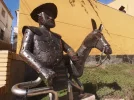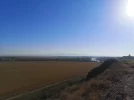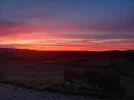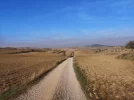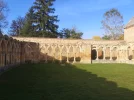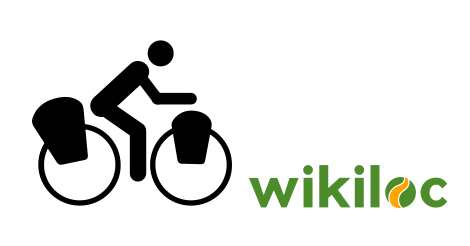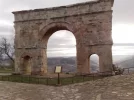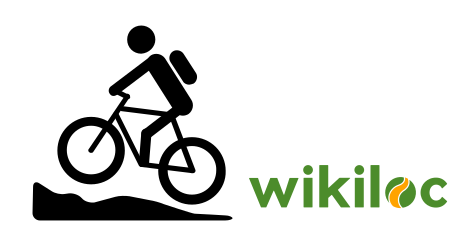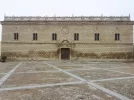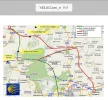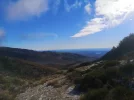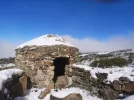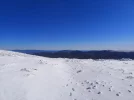- Time of past OR future Camino
- Except the Francés
Covid having cut my 2020 camino short, I have been fortunate to be able to restart it in 2021 at Montserrat. While supposedly under lockdown, the NHS very kindly provided me with a couple of new knees, the more recent one exactly 6 months ago, so now seems as good a time as any to put them both through their paces.
The albergue at Montserrat Is still closed, but the local Amics are allowed to lodge pilgrims in rooms at the Abat Oliba hostal (on the same floor where the albergue normally is), which was fine, 10€. They also very kindly organised a pilgrim blessing for me, after vespers in the chapel behind the moreneta.
As I decided my first day would only be the 16km or so to Castelloli, I could have a leisurely morning up the top. And this year the monastery museum is open again, so I was able to enjoy my favourite Caravaggio for the first time in 15 years, as well as many other masterpieces from el Greco to Dalí.
Rather than follow the usual marked pilgrim path along the road towards the motorway, I took the footpath to the lovely Santa Cova, and then down the mule path (or GR5 "sender dels Miradors") to Collbató. It's a bit of a scramble in places, but nothing too extreme.
The next village on, el Bruc, is unremarkable except in that it can claim to be the first place French troops in Spain were defeated in 1808. An almost certainly apocryphal story claims that a local drummer boy was drumming in the narrow gorge and the echo made it sound as if there were thousands of troops defending the spot, causing the French to retreat.
Anyway, a few km from el Bruc I was reconnected with the yellow arrows, and so on to Castelloli, where I enjoyed an excellent menú del día in Cal Betis, the first bar in the village. They gave me the number code to the albergue, in the former presbytery next to the church. Very large, very comfortable, plenty of hot water to wash clothes and self, free.
Castelloli to Jorba
One of the bars in Castelloli opens at 7, so I was able to have my coffee and be on my way as dawn was breaking. Not that it's a long day but the heat is still nudging the 30s in these parts, so getting a few km under my belt as early as possible appeals. Igualada is the first major town on this route, and a last chance to see the jagged edges of the magic mountain receeding into the heat haze. On the outskirts is a rather fine statue of Antonio Franch ("el Heroe del Bruc") with palm outstretched, looking a bit like a bronze traffic policeman. And just outside town is the really very lovely Romanesque chapel of Sant Jaume, with a wide crack in the apse caused by an earthquake in 1429.
The hospitalero of Jorba is also the parish priest, who also acts as a caterer, so is clearly a very busy man. He is very keen to repeat that he doesn't open until 6 (I think it was 5 to when I saw him at his door and went up). The albergue is fine, but I'm glad I was alone, as I felt rather squashed in a very narrow room with 3 bunks. 10€.

The albergue at Montserrat Is still closed, but the local Amics are allowed to lodge pilgrims in rooms at the Abat Oliba hostal (on the same floor where the albergue normally is), which was fine, 10€. They also very kindly organised a pilgrim blessing for me, after vespers in the chapel behind the moreneta.
As I decided my first day would only be the 16km or so to Castelloli, I could have a leisurely morning up the top. And this year the monastery museum is open again, so I was able to enjoy my favourite Caravaggio for the first time in 15 years, as well as many other masterpieces from el Greco to Dalí.
Rather than follow the usual marked pilgrim path along the road towards the motorway, I took the footpath to the lovely Santa Cova, and then down the mule path (or GR5 "sender dels Miradors") to Collbató. It's a bit of a scramble in places, but nothing too extreme.
The next village on, el Bruc, is unremarkable except in that it can claim to be the first place French troops in Spain were defeated in 1808. An almost certainly apocryphal story claims that a local drummer boy was drumming in the narrow gorge and the echo made it sound as if there were thousands of troops defending the spot, causing the French to retreat.
Anyway, a few km from el Bruc I was reconnected with the yellow arrows, and so on to Castelloli, where I enjoyed an excellent menú del día in Cal Betis, the first bar in the village. They gave me the number code to the albergue, in the former presbytery next to the church. Very large, very comfortable, plenty of hot water to wash clothes and self, free.
Castelloli to Jorba
One of the bars in Castelloli opens at 7, so I was able to have my coffee and be on my way as dawn was breaking. Not that it's a long day but the heat is still nudging the 30s in these parts, so getting a few km under my belt as early as possible appeals. Igualada is the first major town on this route, and a last chance to see the jagged edges of the magic mountain receeding into the heat haze. On the outskirts is a rather fine statue of Antonio Franch ("el Heroe del Bruc") with palm outstretched, looking a bit like a bronze traffic policeman. And just outside town is the really very lovely Romanesque chapel of Sant Jaume, with a wide crack in the apse caused by an earthquake in 1429.
The hospitalero of Jorba is also the parish priest, who also acts as a caterer, so is clearly a very busy man. He is very keen to repeat that he doesn't open until 6 (I think it was 5 to when I saw him at his door and went up). The albergue is fine, but I'm glad I was alone, as I felt rather squashed in a very narrow room with 3 bunks. 10€.

Last edited:

















